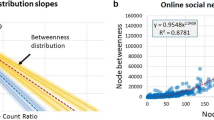Abstract
Under preferential attachment (PA) network growth models late arrivals are at a disadvantage with regard to their final degrees. Previous extensions of PA have addressed this deficiency by either adding the notion of node fitness to PA, usually drawn from some fitness score distributions, or by using fitness alone to control attachment. Here we introduce a new dynamical approach to address late arrivals by adding a recent-degree-change bias to PA so that nodes with higher relative degree change in temporal proximity to an arriving node get an attachment probability boost. In other words, if PA describes a rich-get-richer mechanism, and fitness-based approaches describe good-get-richer mechanisms, then our model can be characterized as a hot-get-richer mechanism, where hotness is determined by the rate of degree change over some recent past. The proposed model produces much later high-ranking nodes than the PA model and, under certain parameters, produces networks with structure similar to PA networks.
Access this chapter
Tax calculation will be finalised at checkout
Purchases are for personal use only
Similar content being viewed by others
References
Bianconi, G., Barabási, A.L.: Competition and multiscaling in evolving networks. EPL (Europhys. Lett.) 54(4), 436 (2001)
Caldarelli, G., Capocci, A., De Los Rios, P., Munoz, M.A.: Scale-free networks from varying vertex intrinsic fitness. Phys. Rev. Lett. 89(25), 258702 (2002)
Fortunato, S., Flammini, A., Menczer, F.: Scale-free network growth by ranking. Phys. Rev. Lett. 96(21), 218701 (2006)
Newman, M.E.: The first-mover advantage in scientific publication. EPL (Europhys. Lett.) 86(6), 68001 (2009)
Medo, M., Cimini, G., Gualdi, S.: Temporal effects in the growth of networks. Phys. Rev. Lett. 107(23), 238701 (2011)
Liao, H., Mariani, M.S., Medo, M., Zhang, Y.C., Zhou, M.Y.: Ranking in evolving complex networks. Phys. Rep. 689, 1–54 (2017)
Zhou, Y., Zeng, A., Wang, W.H.: Temporal effects in trend prediction: identifying the most popular nodes in the future. PLoS One 10(3), 0120735 (2015)
Candia, C., Jara-Figueroa, C., Rodriguez-Sickert, C., Barabási, A.L., Hidalgo, C.A.: The universal decay of collective memory and attention. Nat. Hum. Behav. 3(1), 82 (2019)
Mokryn, O., Wagner, A., Blattner, M., Ruppin, E., Shavitt, Y.: The role of temporal trends in growing networks. PloS One 11(8), e0156505 (2016)
Lehmann, S., Jackson, A., Lautrup, B.: Life, death and preferential attachment. Europhys. Lett. 69(2), 298–303 (2005)
Alstott, J., Bullmore, E., Plenz, D.: powerlaw: a Python package for analysis of heavy-tailed distributions. PloS One 9(1), e85777 (2014)
Author information
Authors and Affiliations
Corresponding author
Editor information
Editors and Affiliations
Rights and permissions
Copyright information
© 2021 The Author(s), under exclusive license to Springer Nature Switzerland AG
About this paper
Cite this paper
Nsour, F., Sayama, H. (2021). Hot-Get-Richer Network Growth Model. In: Benito, R.M., Cherifi, C., Cherifi, H., Moro, E., Rocha, L.M., Sales-Pardo, M. (eds) Complex Networks & Their Applications IX. COMPLEX NETWORKS 2020 2020. Studies in Computational Intelligence, vol 944. Springer, Cham. https://doi.org/10.1007/978-3-030-65351-4_43
Download citation
DOI: https://doi.org/10.1007/978-3-030-65351-4_43
Published:
Publisher Name: Springer, Cham
Print ISBN: 978-3-030-65350-7
Online ISBN: 978-3-030-65351-4
eBook Packages: EngineeringEngineering (R0)




